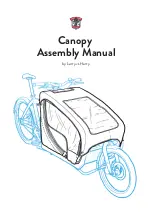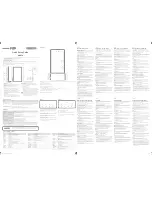
2
Publication No: EN-VARTA-NB-IS-001 - September 2006
www.enersys.com
1. Receiving the battery
The cells are not to be stored in packaging, therefore, unpack the
battery immediately after arrival. Do not overturn the package. The
battery cells are equipped with a blue plastic transport plug.
The battery can be delivered:
Filled and charged / the battery is ready for installation. Replace
the transport plug with the vent cap included in our accessories
just before use
Filled and discharged / Replace the transport plug with the vent
cap included in our accessories just before use
Unfilled and discharged / do not remove the transport plug until
ready to fill the battery.
Before any electrical operation is carried out on the new battery it
has to be ensured that cells are filled with electrolyte and the
transport plugs are removed from the cells and replaced by vent
plugs.
2. Storage
The rooms provided for storing the batteries must be clean, dry,
cool (+10°C to 30°C - in compliance with IEC 60623) and well
ventilated. The cells are not to be stored in closed packaging and
must not be exposed to direct sunlight or UV-radiation.
If the cells are delivered in plywood boxes, open the boxes before
storage and remove the packing material on the top of the cells. If
the cells are delivered on pallets remove the packing material on
the top of the cells.
2.1 Uncharged and unfilled cells
Provided the correct storage conditions are met then the cells and
batteries can be stored for long periods without damage if they are
deeply discharged, drained and well sealed. It is very important that
the cells are sealed with the plastic transport plug tightly in place. It
is necessary to check the transport plug after receipt and at least
every year. Leaky plugs allow the carbon dioxide from the
atmosphere to infiltrate the cell, which will result in carbonation of
the plates. This may influence the capacity of the battery.
2.2 Charged and filled cells/ discharged and filled cells
Filled cells can be stored for up to 12 months from the time of
delivery.
Storage of filled cells at a temperature above +30°C results in loss of
capacity of approximately 5% per 10°C per year. It is very important
that the cells are sealed with the plastic transport plugs tightly in
place. In case of loss of electrolyte during transportation, refill the
cell with distilled water to the “MIN” mark before storage.
3. Installation
Battery installations have to be in accordance with EN 50272-2:2001.
For non stationary installations specific standards are valid.
3.1 Location
Install the battery in a dry and clean room. Avoid direct sunlight and
heat in all cases. The battery will give the optimal performance and
maximum service life if the ambient temperature lies between
+10°C and +30°C.
3.2 Ventilation
Before end of charge, battery can release a mixture of oxygen and
hydrogen which is directly proportional to the charge current. At
normal float charge the gas evolution is very small but some
ventilation is necessary.
Special regulations for ventilation might be required in your area
for certain applications.
3.3 Setting up
Always follow the assembly drawings, circuit diagrams and other
separate instructions. The transport plugs have to be removed by
the vent caps included in the accessories. If batteries are supplied
“filled and charged”, first of all the electrolyte level should be
checked and if necessary topped up as described in point 3.4.
Cell connectors and/or flexible cables should be checked to ensure
they are tightly fixed. Terminal nuts, screws and connectors must be
tightly fixed. If necessary tighten with a torque wrench.
Torque loading for:
M10: 8 Nm
M16: 20 Nm
M20: 25 Nm
Female thread:
M 8: 20 - 25 Nm
M10: 25 - 30 Nm
The connectors and terminals should be corrosion-protected by
coating with thin layer of anti-corrosion grease.
3.4 Electrolyte
The electrolyte for NiCd batteries is a diluted caustic potash solution
(specific gravity 1.20 kg/litre ± 0.01 kg/litre) with a lithium hydroxide
component, in accordance with IEC 60993. The caustic potash
solution is prepared in accordance with factory regulations. The
specific gravity of the electrolyte does not indicate the charging state
of the battery. It changes only slightly during charging and
discharging and is only minimally related to the temperature.
Battery delivered unfilled and discharged / if the electrolyte is
supplied dry, it is to be mixed according to the enclosed mixing
instruction. Remove the transport plugs from the cell just before
filling. Fill the cells up to 20 mm above the lower level mark “MIN”.
Steel cased cells have to be filled up to the top edge of the plates.
When using battery racks, fill cells before installing. Only use
genuine electrolyte.
Battery delivered filled and charged or discharged / check
electrolyte level. It should not be less than 20 mm below the upper
level mark “MAX” (see 5.2).
3.5 Commissioning
A good commissioning is very important. The following instructions
are valid for commissioning between 20°C to 30°C. For different
conditions please contact the manufacturer. Charging at constant
current is preferable. If a site test is requested it has to be carried out
in accordance with IEC 60623.
According to IEC 60623, 0.2C
5
A is also expressed as 0.2 l
t
A.
The reference test current is expressed as:
l
t
A= Cn Ah
1 h
3.5.1 Commissioning with constant current
Battery delivered unfilled and discharged / after a period of 5 hours
from filling the electrolyte, the battery should be charged for
15 hours at the rated charging current 0.2 l
t
A. Approximately
4 hours after the end of charging the electrolyte level should be
adjusted to the upper electrolyte level marked “MAX” by using only
genuine electrolyte. For cells with steel cases the electrolyte level
should be adjusted to the maximum level according to the
“Instruction for the control of electrolyte level”. During the charge
the electrolyte level and temperature should be observed (see point
5.4). The electrolyte level should never fall below the “MIN” mark.






















